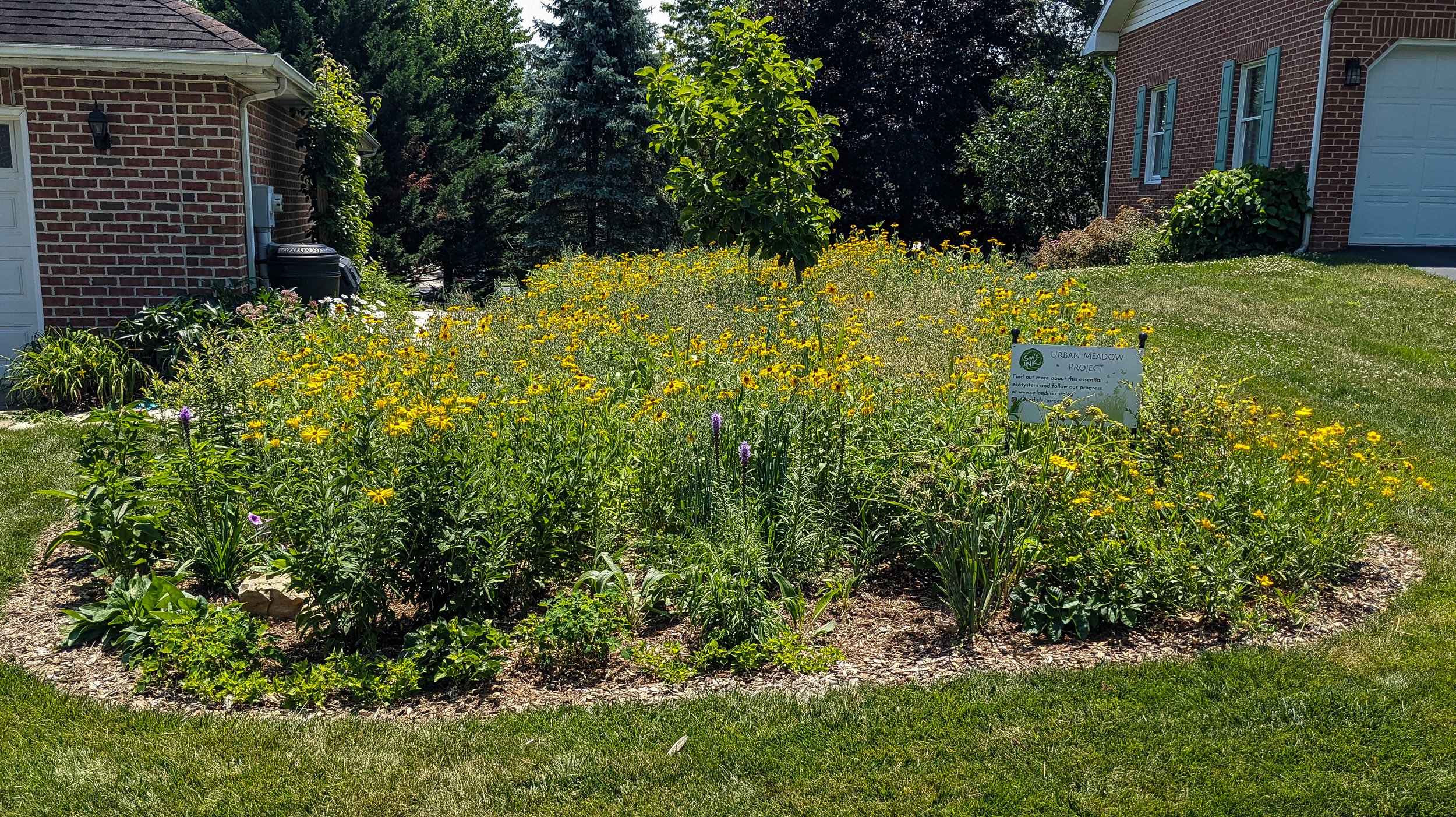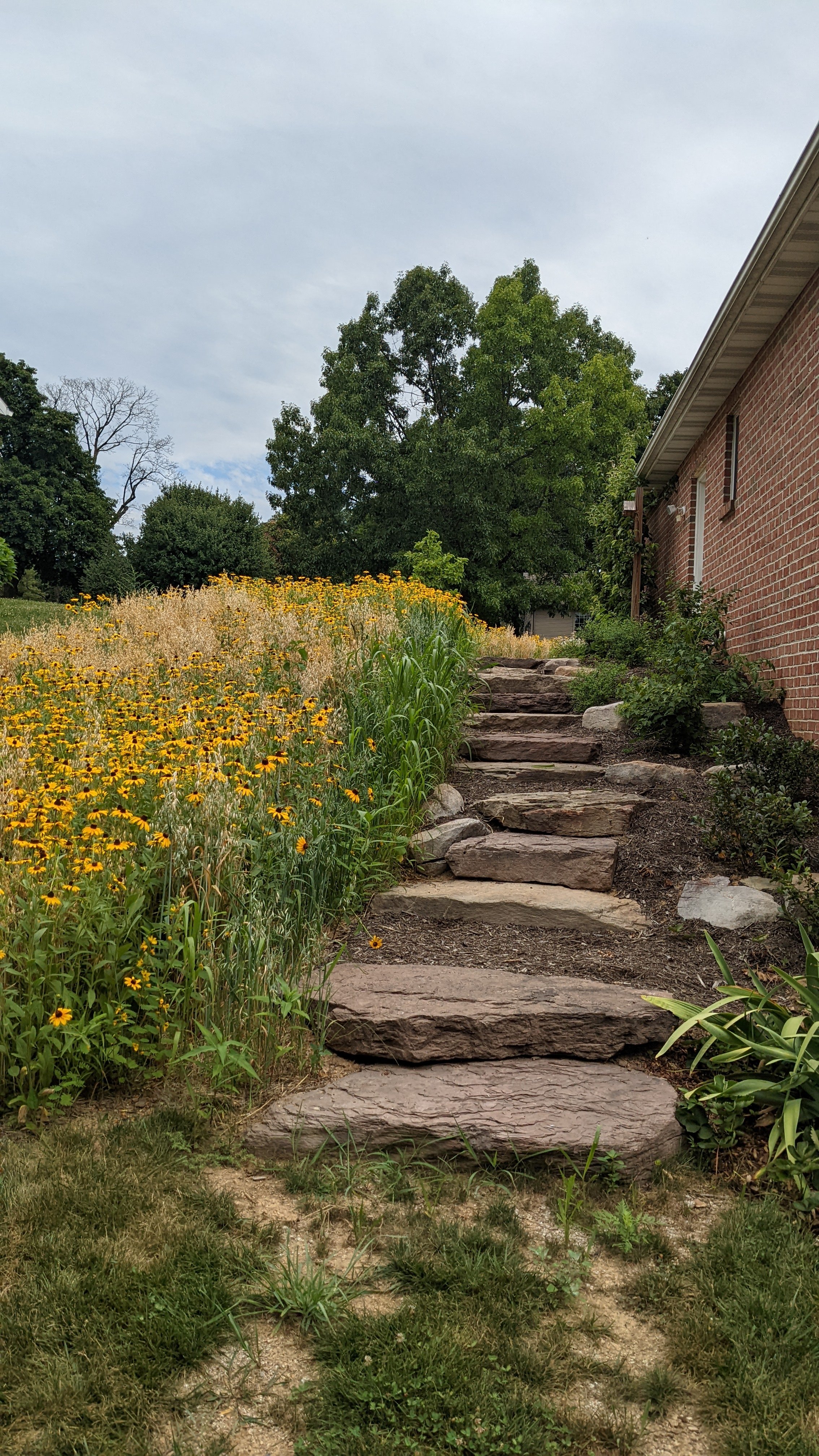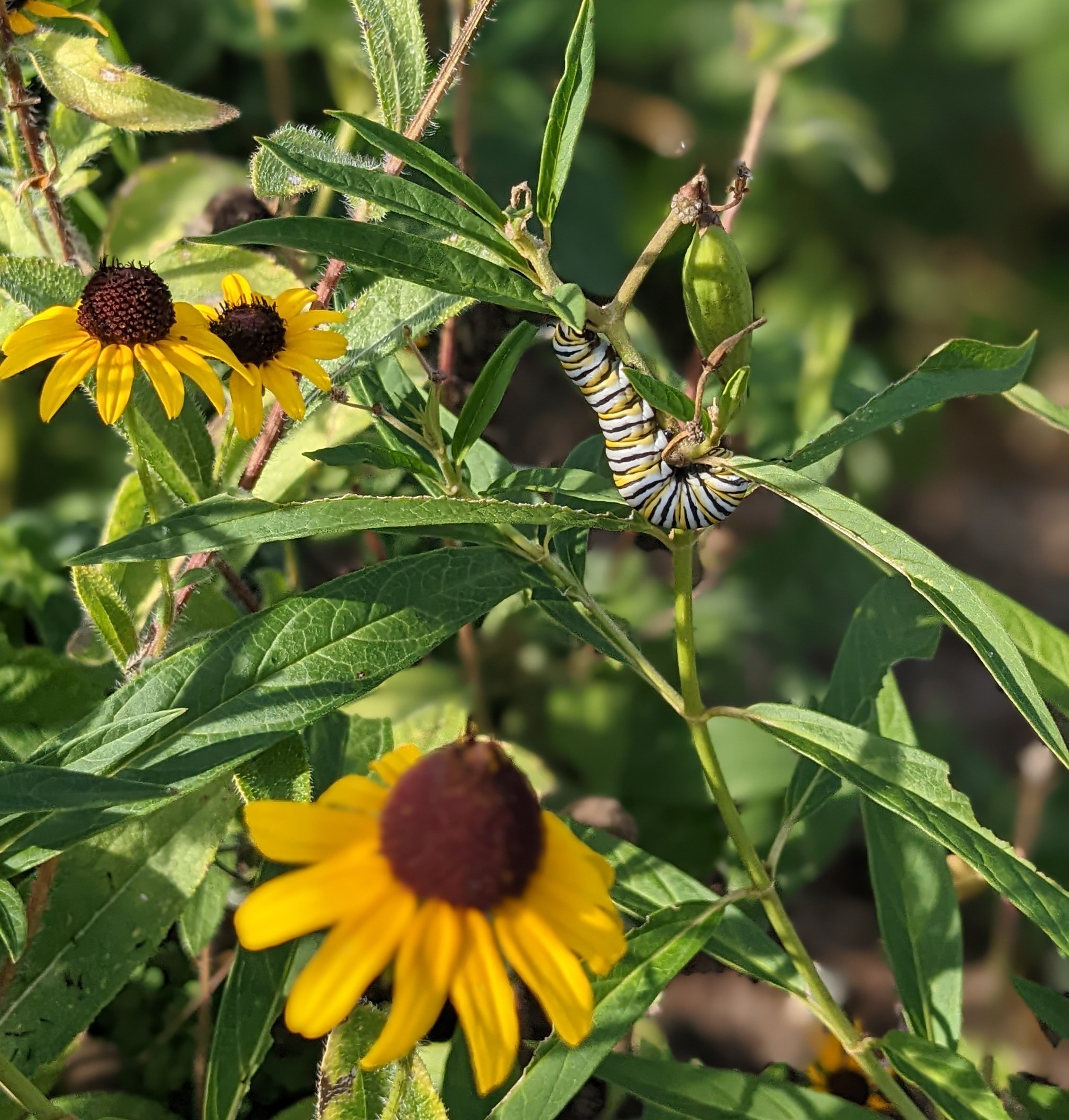The making of a meadow
Landscape designer shares how she made her meadow garden
Removing sod and replacing it with a meadow is slowly taking root with progressive gardeners looking for a more natural approach to their landscape.
These gardeners are building meadows in the front, back and side yards to welcome wildlife that has had to make due with small islands of native and non-native plants and flowers for so many years.
Landscaper Angela den Hoed is one of these gardeners who have recognized the importance of meadow and prairie gardens and have taken the challenge of converting a large swath of turf in the front/side of her Carlisle, Pennsylvania home into a meadow.
It was a project that certainly came with its challenges. She chose to go with the most labour-intensive approach and, although the results after the first year appears incredibly successful, she admits it was a real learning process.
It just so happens, that was actually one of the key points of the entire project.
• If you are looking for ideas on using low-growing ornamental grasses, be sure to check out my post on Five low-growing ornamental grasses for the garden.
• More on Angela’s move from Engineering to Landscape designer here.
• More on Angela’s Woodland Garden design here.
Angela explains that installing the meadow was an important learning opportunity which she hopes to be able to take advantage of in future work with her landscaping clients, many of whom are beginning to ask about removing some or all of their grass in areas of their landscape to create a meadow garden.
In their book, Garden Revolution, How our Landscapes can be a source of Environmental Change, Larry Weaner and Thomas Christopher, write: “Native meadow is likely the best answer to North America’s over reliance on lawn, a means of saving the enormous quantities of water, fertilizer, herbicides, pesticides, and fossil fuels annually invested in the cultivation of turf. Unlike shrublands and forests, meadows can be established from seed in a relatively short time to gravitate toward open space and expansive views, attributes not common in a forest or shrubland.”
The authors ask why, then, does grass continue to dominate our landscapes?
They point to the quality of seed that has been sold in the past to create these meadows and the desire by homeowners to have an instant meadow in a single season.
For more on meadow gardening, check out my post: Fields of Gold: Sunflowers and Goldfinches.
“Meadows can work, but only if the gardener selects plants and uses techniques that reflect the local habitats and ecological processes that will affect their survival and proliferation. This is why successful meadow will look quite different in different regions.”
Their approach to creating a successful meadow is a fascinating look at working with nature using native plants and a more ecological approach. Although it is aimed at creating and maintaining large meadows with the least amount of work, their approach is certainly one that works in a mini meadow-inspired garden.
If you have visions for a larger meadow, Garden Revolution is a must read gardening guide to creating meadows and other inspirational gardens by working with native plants.
If you are interested in exploring this approach in greater detail, check out my more extensive post on Garden Revolution here.
Back to Angela’s experience installing her meadow garden. I could try to explain the process in my own words, but I think it’s best to allow Angela to tell her story in her own words.
The following is a series of questions and answers for Angela about her experience.
1) What are your short- and long-term goals with the creation of your meadow garden?
My immediate goal with the meadow project is to gain experience in meadow making that I can share with my clients and followers. My clients are starting to ask for seeded meadows, and I felt the best way to really understand it was to do it myself on my own property, using materials available to regular homeowners rather than landscape companies. Long-term I want the meadow to be an example for my clients, neighbours, and the general public to see what is possible in a typical residential site. I hope it shows the ecological and economic advantages of a native planting vs. mowed lawn.
2) I have been following your progress on Instagram an it showed that the creation of the meadow seemed like a lot of work. Would you recommend it for the average do-it-yourselfer or do you think it is better left to professionals like yourself?
The average do-it-yourselfer is totally capable of planting a seeded meadow on this scale. Once you get to maybe 1/2 acre or more, it may be better to hire a trained landscape crew. We did go with the most labour-intensive method of site prep, which I would definitely NOT recommend.
Our options for sod removal were to solarize, use herbicide, or cut it out with a sod cutter. We missed our window of sunny summer months for solarization and didn’t want to spray glyphosate on 1000 ft² of lawn. So, the sod cutter was an experiment. Rolling up and hauling away the sod was the labor-intensive part, and we still ended up needing to spot spray with glyphosate anyway.
The other site prep methods take a lot less hands-on time.
Is there a lot of maintenance in a new meadow garden?
3) How about up-keep since you put it in. Has it taken up a lot of your time keeping weeds etc under control?
With the sod cutter, I was hoping to not only cut out the grass, but any weed seeds as well. Unfortunately, here in the Mid-Atlantic we have centuries of weed seed deposits in the soil (the seed bank) and they can remain viable for a very long time. I was shocked at how many weeds came up, both before and after we seeded the meadow plants.
Afterall, this area had been lawn grass for 25 years. Weeds are generally a problem if they interfere with the meadow plants germinating (blocking their light) so I wanted a clean slate for seeding. I used the scuffle hoe at first, but eventually I resorted to glyphosate.
After planting, more weeds germinated. Most of these were benign albeit surprising (petunias?). Once the meadow plants germinate, they can generally outcompete the weeds, but a few more thuggish ones needed to be removed like mugwort, thistle, morning glory, mulberry trees, even a butterfly bush.
The biggest problem is the yellow nutsedge, which I will need to stay on top of for a few years. Weeding actually doesn’t take much time at all. I'm out there all the time checking out what’s going on, but only go after the weeds maybe twice a month. Most of them would not have had the chance to germinate if we had used a different site prep method. I anticipate a lot less problematic weeds in year two.
4) Where did you get your inspiration to create the meadow?
I’m not sure there was just one point of inspiration to create the meadow. It was probably a combination of naturalistic design books and classes that I’ve taken – I’m inspired by the work of Claudia West, Benjamin Vogt, Kelly Norris, Roy Diblik, Adam Woodruff, Noel Kingsbury, James Hitchmough, and others.
Naturalistic design and science-based ecologically beneficial plantings are where my heart is but are a pretty foreign concept for most homeowners. It’s a hard sell to clients when there’s no local example to refer them to. My garden has always been my experimental space, and now it's becoming demonstration space as well. A seeded meadow is at the far end of the “wildness” scale in terms of garden design. I hope to do a more intentionally designed plug-planted perennial “meadow” garden in the future, which I think bridges the gap between a seeded meadow and a traditionally planted garden with larger groupings of plants.
5) What are your plans for the meadow this year. Any additions, plant removals?
This will be year two for the meadow. In the first year the most visible plants were the nurse crop of oats and the mass of Rudbeckia. These will be significantly less prominent as more perennials and grasses start to take hold and bloom.
The first thing we will do this year is the cutback in late March, along with spot-spraying the clumps of lawn grass that came back up in year one. The front street-facing edge of the meadow was planted with potted plants in a more traditional garden arrangement to indicate intentionality. This part of the garden may get rearranged a bit this year, I am still holding space for a bit of artwork to be added there as well.
How long before wildlife show up in a meadow garden?
6) What wildlife did you see in the meadow this year?
I think it takes a while for the wildlife to find your new native plants. At least in the rest of my property that seems to be the case. However, there was a small flock of birds that were always hanging out at the bottom of the hill during the summer; they would all fly out when I walked by. There were plenty of bees, and a handful of monarch caterpillars on the milkweed. We also saw a hawk sitting on the roof looking over the meadow, he must think it’s a good place to hunt. I imagine a lot of the neighborhood rabbits will be moving in this spring.
7) What has been the reaction of neighbours on the street about the meadow.
The reaction has been positive. I’m sure they all thought we were crazy when we removed the sod last fall and it looked like a giant swath of bare soil until the seeds germinated in May. One neighbour said she wished she was brave enough to do the same thing. I have noticed a lot more walkers on our street since plants started blooming.
8) Is there anything you would have done differently if you could design and install it again. Tips for people thinking about creating one of their own.
I would definitely have used solarization as my site prep method. This requires more planning and patience. Basically, you must scalp the grass and then cover with black or clear plastic starting in June when the weather heats up, then leave it in place until just before you seed. This kills both the grass and the seeds in the very top layer of soil, and you can seed in the fall, winter, or spring. Giant sheets of plastic are not super neighbour-friendly though, so if doing this in a very visible area, glyphosate may be a better option. It also depends on the size of the meadow, as sheets of plastic will end up in the landfill. It’s a balance of size and your priorities. A few applications of glyphosate in the months before planting will also do the job, but many are uncomfortable with that.
I also should have eliminated the nutsedge ahead of time. The nutlets live 8+ inches below the surface and can prevent other seeds from germinating.
It will be a while before I know if I’m happy with my seed selection. I decided to not complicate it too much with a totally custom seed mix. I started with a readily available mix from Ernst Seeds and had them modify it by upping the percentage of perennials and lowering that of grasses. That’s primarily to get a heavier floral display in the meadow and help the neighbours see it as more of a garden. I also put in some plugs of Echinacea pallida (pale purple coneflower) and Eryngium yuccifolium (rattlesnake master) in small groupings for a little added interest. Hopefully the rabbits didn’t eat all of them! I can always add in a few other species in the future.
Five favourite plants for the meadow garden
9) What agricultural zone are you growing it in and what are the top 5 plants in your meadow?
I am in USDA growing zone 6b, in the Ridge and Valley ecoregion.
I would say the top most recognizable plants in the meadow would be:
• Echinacea purpurea (purple coneflower)
• Rudbeckia hirta (Blackeyed Susan)
• Asclepias syriaca (common milkweed)
• Aster novae-angliae (New England Aster)
• Monarda fistula (wild bergamot).
Why is a meadow is so important to the ecosystem?
10) Why is creating a meadow so important for gardeners and lovers of the natural world?
A meadow is an alternative style of garden that more accurately mimics how plants grow in nature. There is a much higher plant density than you find in a traditional garden setting, and consequently opportunity for much higher diversity – both in the plant species and the wildlife it can serve.
Even a tiny micro-meadow can pack in a lot of diversity.
There are 23 different plants in my seed mix plus the two plants added as plugs. With a seed mix, you can plant any size of garden with that much diversity in it. You are also hedging your bets against plant failure – if one or two plants don’t thrive in your specific conditions, there are plenty of other species that will fill in the gaps.
The obvious benefits of planting natives include providing food and habitat for local wildlife and supporting the local food web (hawks included!).
Beyond these are the reductions in fertilizer, fossil fuels, and noise and air pollution generated by lawn maintenance. We also get the additions of better stormwater absorption, improved soil health, and much higher carbon sequestration. These are ecosystem services that have been stripped from the original landscape and need to be restored as best we are able.






